Verification of the Influence of the 2-Hydroxy-2-methylpropiophenone (Photoinitiator) Content in Hydrogel Materials on Their Physicochemical Properties and Surface Morphology
Abstract
1. Introduction
2. Materials and Methods
2.1. Materials
2.2. Synthesis of Hydrogels via the Photopolymerization Process
2.3. Hydrogels’ Incubation in Solutions Simulating Physiological Liquids
2.4. Characterization of Hydrogels’ Swelling Properties
2.5. Analysis of the Hydrogels’ Tensile Strengths and Percentage Elongations
2.6. Analysis of the Structure of Developed Hydrogels using Fourier Transform Infrared (FT-IR) Spectroscopy
2.7. Studies on Hydrogels’ Wettability towards Polar and Non-Polar Liquids
2.8. Characterization of Hydrogels’ Morphologies Using the SEM Technique
2.9. Analysis of the Morphology and Roughness of Hydrogels Using Digital Microscopy
3. Results and Discussion
3.1. Results of the Incubation Studies
3.2. Results of Studies on the Sorption Properties of Hydrogels
3.3. Results of the Mechanical Investigations
3.4. Analysis of the Hydrogels Using FT-IR Spectroscopy
3.5. Investigations on Hydrogels’ Wettability
3.6. Results of the Hydrogels’ SEM Imaging
3.7. Characterization of the Hydrogels’ Morhology and Roughness via Digital Microscopy
4. Conclusions
- Most of the hydrogels showed stability in simulated physiological liquids. The only hydrogel which slightly degraded in one liquid (distilled water) was the sample obtained using the lowest amount of the photoinitiator. This was probably due to an insufficient degree of crosslinking.
- All hydrogels exhibited swelling properties in simulated physiological liquids—their swelling ratios were within the range of 2.0–3.0 g. The highest level of sorption was reported in distilled water, which was caused by the lack of ions in this medium; this might have caused the increase in the degree of crosslinking in hydrogels.
- As the amount of photoinitiator in the structure of tested hydrogel increased, the percentage elongation also increased, and the tensile strength of such hydrogels decreased.
- All of the hydrogels displayed hydrophilicity. Importantly, as the amount of photoinitiator increased in the structure of the tested hydrogel, the hydrophilicity (the lower wetting angle) also increased.
- As the photoinitiator in the structure of tested hydrogel increased, the surface morphology of the hydrogel became smoother and more homogeneous.
- The presented synthesis methodology allowed us to prepare materials of various shapes and sizes, without the need for further processing. Furthermore, there were no by-products that emerged from a reaction time of only 120 s. Developed materials showed relatively high roughness and surface hydrophilicity levels, which may additionally promote cell proliferation and support regeneration processes. Due to the demonstrated physicochemical properties of hydrogels, these materials may be subjected to further, more advanced studies verifying their biocompatibility and other characteristics, thus enabling them to be useful for biomedical applications (e.g., as dressing materials).
Author Contributions
Funding
Institutional Review Board Statement
Informed Consent Statement
Data Availability Statement
Conflicts of Interest
References
- Xu, L.; Sheybani, N.; Yeudall, W.A.; Yang, H. The effect of photoinitiators on intracellular AKT signaling pathway in tissue engineering application. Biomate. Sci. 2015, 3, 250–255. [Google Scholar] [CrossRef] [PubMed]
- Choi, J.R.; Yong, K.W.; Choi, J.Y.; Cowie, A.C. Recent advances in photo-crosslinkable hydrogels for biomedical applications. Biotechniques 2019, 66, 40–53. [Google Scholar] [CrossRef]
- Emami, N.; Soderholm, K.J. Influence of light-curing procedures and photo-initiator/co-initiator composition on the degree of conversion of light-curing resins. J. Mater. Sci. Mater. Med. 2005, 16, 47–52. [Google Scholar] [CrossRef]
- Ferracane, J.L. Hygroscopic and hydrolytic effects in dental polymer networks. Dent. Mater. 2006, 22, 211–222. [Google Scholar] [CrossRef]
- Hong, B.M.; Park, S.A.; Park, W.H. Effect of photoinitiator on chain degradation of hyaluronic acid. Biomater. Res. 2019, 23, 21. [Google Scholar] [CrossRef] [PubMed]
- Nasir, N.; Kumar, S.; Kim, M.; Nguyen, V.H.; Suleman, M.; Park, H.M.; Lee, S.; Kang, D.; Seo, Y. Effect of the Photoinitiator Concentration on the Electro-optical Properties of Thiol–Acrylate-Based PDLC Smart Windows. ACS Appl. Energy Mater. 2022, 5, 6986–6995. [Google Scholar] [CrossRef]
- Bertolo, M.V.L.; Moraes, R.C.M.; Pfeifer, C.; Salgado, V.E.; Correr, A.R.C.; Schneider, L.F.J. Influence of Photoinitiator System on Physical-Chemical Properties of Experimental Self-Adhesive Composites. Braz. Dent. J. 2017, 28, 35–39. [Google Scholar] [CrossRef]
- Salehi, B.; Albayrak, S.; Antolak, H.; Kręgiel, D.; Pawlikowska, E.; Sharifi-Rad, M.; Uprety, Y.; Tsouh Fokou, P.V.; Yousef, Z.; Amiruddin Zakaria, Z.; et al. Aloe Genus Plants: From Farm to Food Applications and Phytopharmacotherapy. Int. J. Mol. Sci. 2018, 19, 2843. [Google Scholar] [CrossRef]
- Darzi, S.; Paul, K.; Leitan, S.; Werkmeister, J.A.; Mukherjee, S. Immunobiology and Application of Aloe vera-Based Scaffolds in Tissue Engineering. Int. J. Mol. Sci. 2021, 22, 1708. [Google Scholar] [CrossRef]
- Praseetha, P.K.; Nijam, M.A.; Vibala, B.V.; Sreedevy, K.; Vijayakumar, S. Aloe-vera conjugated natural Carbon Quantum dots as Bio-enhancers to accelerate the repair of chronic wounds. Ind. Crops Prod. 2021, 174, 114152. [Google Scholar]
- Kung, J.C.; Tseng, I.T.; Chien, C.S.; Lin, S.H.; Wang, C.C.; Shih, C.J. Microwave assisted synthesis of negative-charge carbon dots with potential antibacterial activity against multi-drug resistant bacteria. RSC Adv. 2020, 10, 41202–41208. [Google Scholar] [CrossRef] [PubMed]
- Cherukuri, S.; Thiruppathi, M.; Vuppalapati, L. Formulation and optimization of novel dexibuprofen- Aloe vera deformable emulgels for enhanced anti-inflammatory activity. J. Drug Deliv. Sci. Technol. 2022, 69, 103171. [Google Scholar] [CrossRef]
- Sharifi, E.; Chehelgerdi, M.; Fatahian-Kelishadrokhi, A.; Yazdani-Nafchi, F.; Ashrafi-Dehkordi, K. Comparison of therapeutic effects of encapsulated Mesenchymal stem cells in Aloe vera gel and Chitosan-based gel in healing of grade-II burn injuries. Regen. Ther. 2021, 18, 30–37. [Google Scholar] [CrossRef] [PubMed]
- Murugesan, M.P.; Ratnam, M.V.; Mengitsu, Y.; Kandasamy, K. Evaluation of anti-cancer activity of phytosomes formulated from Aloe vera extract. Mater. Today: Proc. 2021, 42, 631–636. [Google Scholar] [CrossRef]
- Valizadeh, A.; Darvishi, M.H.; Amani, A.; Zarchi, A.A.K. Design and development of novel formulation of Aloe Vera nanoemulsion gel contained erythromycin for topical antibacterial therapy: In vitro and in vivo assessment. J. Drug Deliv. Sci. Technol. 2022, 74, 103519. [Google Scholar] [CrossRef]
- Nasef, S.M.; Khozemy, E.E.; Kamoun, E.A.; El-Gendi, H. Gamma radiation-induced crosslinked composite membranes based on polyvinyl alcohol/chitosan/AgNO3/vitamin E for biomedical applications. Int. J. Biol. Macromol. 2019, 137, 878–885. [Google Scholar] [CrossRef]
- Guler, E.; Baripoglu, Y.E.; Alenezi, H.; Arikan, A.; Babazade, R.; Unal, S.; Duruksu, G.; Alfares, F.S.; Yazir, Y.; Oktar, F.N.; et al. Vitamin D3/vitamin K2/magnesium-loaded polylactic acid/tricalcium phosphate/polycaprolactone composite nanofibers demonstrated osteoinductive effect by increasing Runx2 via Wnt/β-catenin pathway. Int. J. Biol. Macromol. 2021, 190, 244–258. [Google Scholar] [CrossRef]
- Hussain, O.; Ahmad, B.; Saleem, S. Tribological performance of biomedical grade UHMWPE/nano-Al2O3/Vitamin-C hybrid composite for cartilage replacements. Mater. Lett. 2021, 291, 129515. [Google Scholar] [CrossRef]
- Kędzierska, M.; Bańkosz, M.; Potemski, P. Studies on the Impact of the Photoinitiator Amount Used during the PVP-Based Hydrogels’ Synthesis on Their Physicochemical Properties. Materials 2022, 15, 6089. [Google Scholar] [CrossRef]
- ISO 527-2:2012; Tensile Properties of Plastics—Determination of Tensile Properties—Part 2: Test Conditions for Moulding and Extrusion Plastics. ISO/TC 61/SC 2 Mechanical behavior. Technical Committee: Geneva, Switzerland, 2012.
- ISO 37:2017; Rubber, Vulcanized or Thermoplastic—Determination of Tensile Stress-Strain Properties. ISO/TC 45/SC 2 Testing and Analysis. Technical Committee: Geneva, Switzerland, 2017.
- Kudłacik-Kramarczyk, S.; Głąb, M.; Drabczyk, A.; Kordyka, A.; Godzierz, M.; Wróbel, P.S.; Krzan, M.; Uthayakumar, M.; Kędzierska, M.; Tyliszczak, B. Physicochemical Characteristics of Chitosan-Based Hydrogels Containing Albumin Particles and Aloe vera Juice as Transdermal Systems Functionalized in the Viewpoint of Potential Biomedical Applications. Materials 2021, 14, 5832. [Google Scholar] [CrossRef]
- Owens, D.K.; Wendt, R.C. Estimation of the surface free energy of polymers. J. Appl. Polym. Sci. 1969, 13, 1741–1747. [Google Scholar] [CrossRef]
- ISO-4287:1997; Geometrical Product Specifications (GPS)—Surface Texture: Profile Method—Terms, Definitions and Surface Texture Parameters. ISO/TC 213 Dimensional and Geometrical Product Specifications and Verification: Geneva, Switzerland, 1997.
- Khan, S.; Ranjha, N.M. Effect of degree of cross-linking on swelling and on drug release of low viscous chitosan/poly(vinyl alcohol) hydrogels. Polym. Bull. 2014, 71, 2133–2158. [Google Scholar] [CrossRef]
- Khalid, S.H.; Qadir, M.I.; Massud, A.; Ali, M.; Rasool, M.H. Effect of degree of cross-linking on swelling and drug release behaviour of poly(methyl methacrylate-co-itaconic acid) [P(MMA/IA)] hydrogels for site specific drug delivery. J. Drug Del. Sci. Tech. 2009, 19, 413–418. [Google Scholar] [CrossRef]
- Jantrawut, P.; Bunrueangtha, J.; Suerthong, J.; Kantrong, N. Fabrication and Characterization of Low Methoxyl Pectin/Gelatin/Carboxymethyl Cellulose Absorbent Hydrogel Film for Wound Dressing Applications. Materials 2019, 12, 1628. [Google Scholar] [CrossRef] [PubMed]
- Law, K.Y. Water–surface interactions and definitions for hydrophilicity, hydrophobicity and superhydrophobicity. Pure Appl. Chem. 2015, 87, 759–765. [Google Scholar]
- Rosqvist, E.; Niemela, E.; Venu, A.P.; Kummala, R.; Ihalainen, P.; Toivakka, M.; Eriksson, J.; Peltonen, J. Human Dermal Fibroblast proliferation controlled by surface roughness of two-component nanostructured latex polymer coatings. Colloids Surf. B Biointerfaces 2019, 174, 136–144. [Google Scholar] [CrossRef]
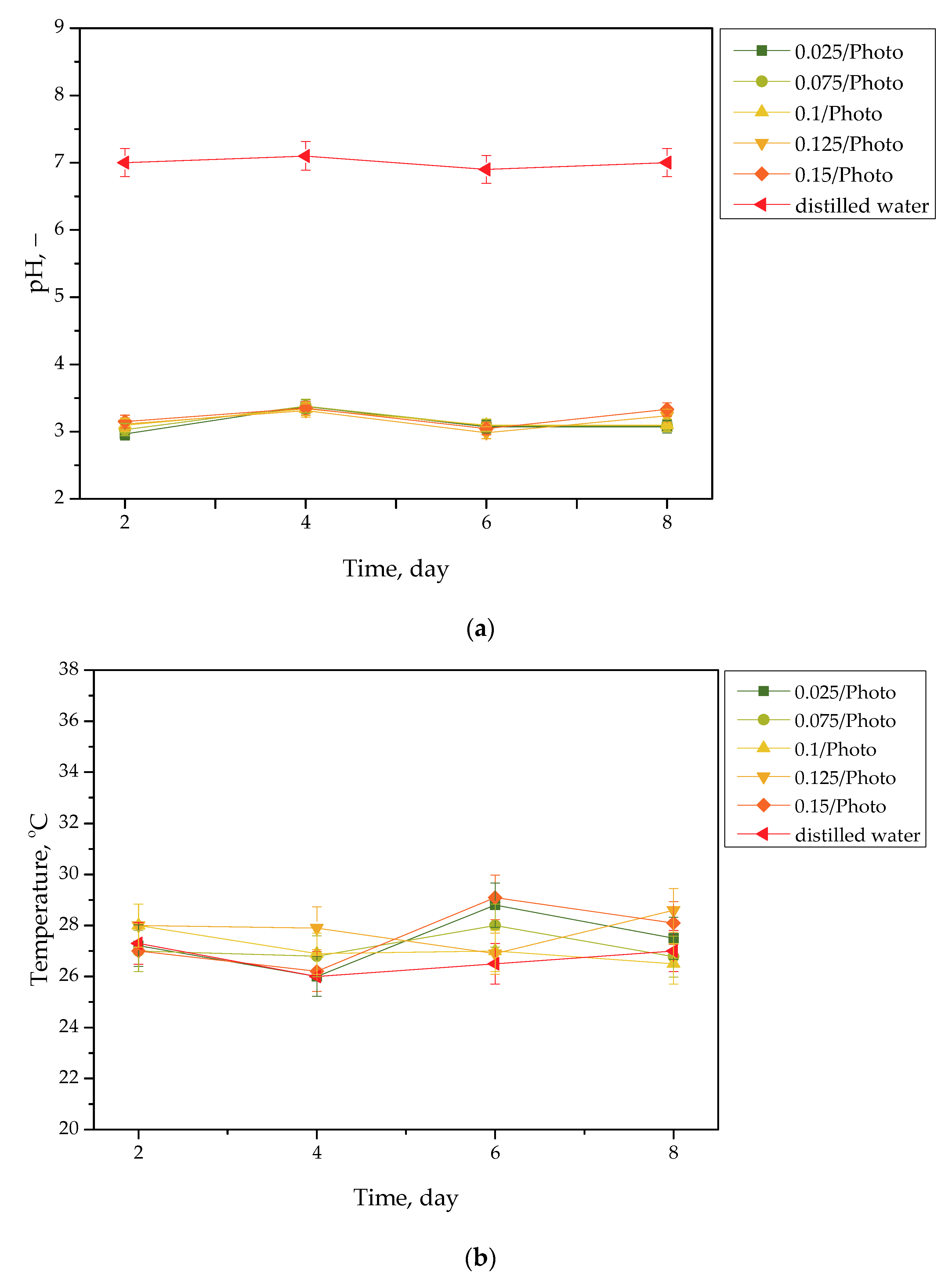

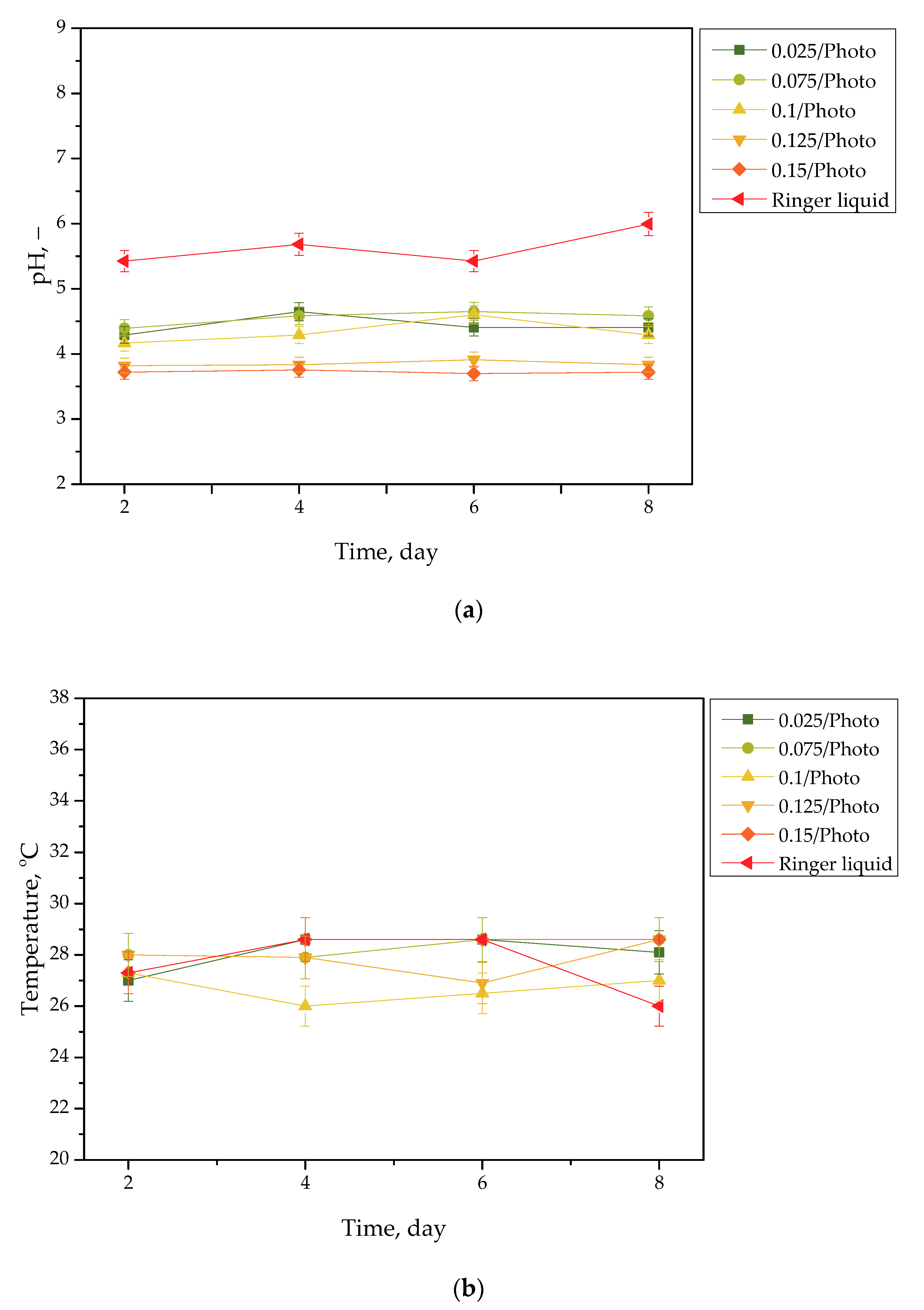
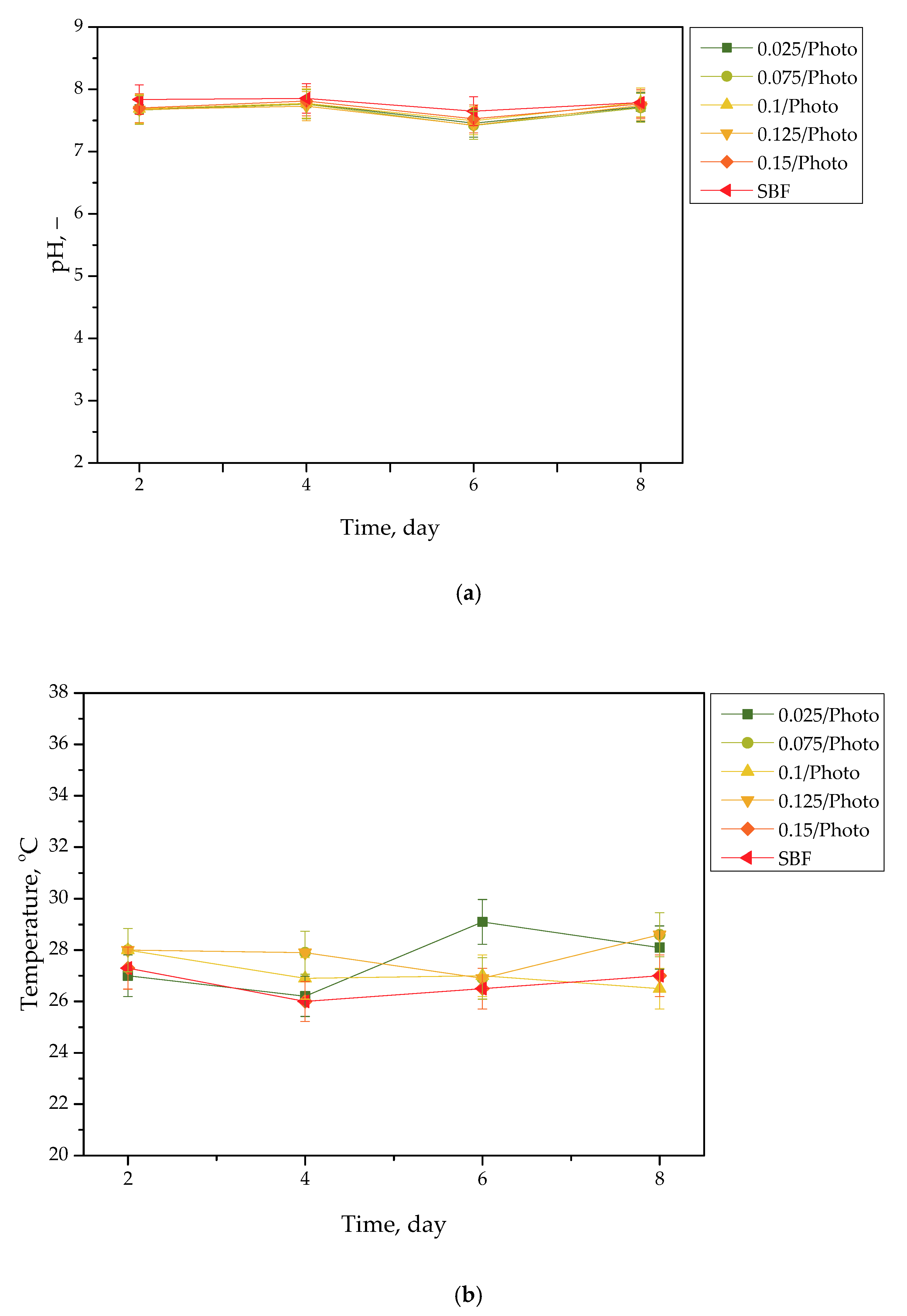
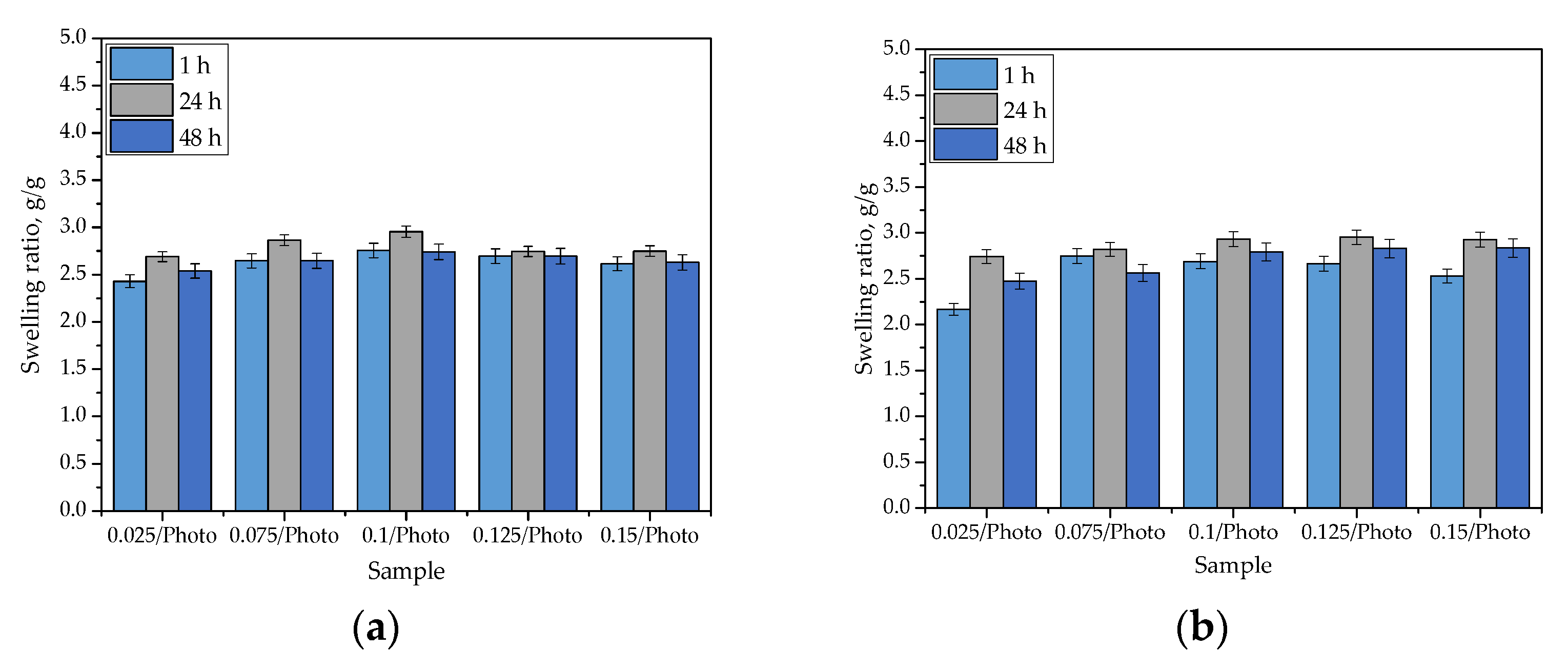

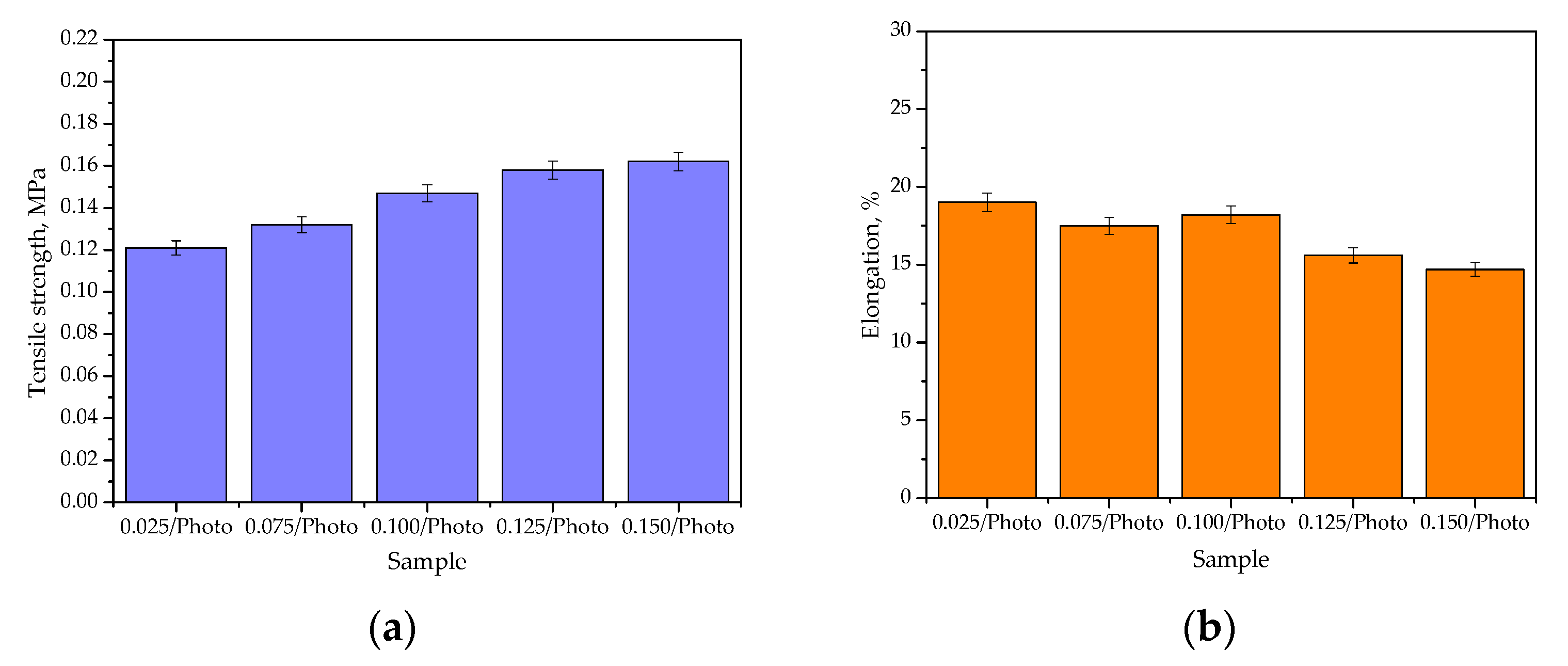
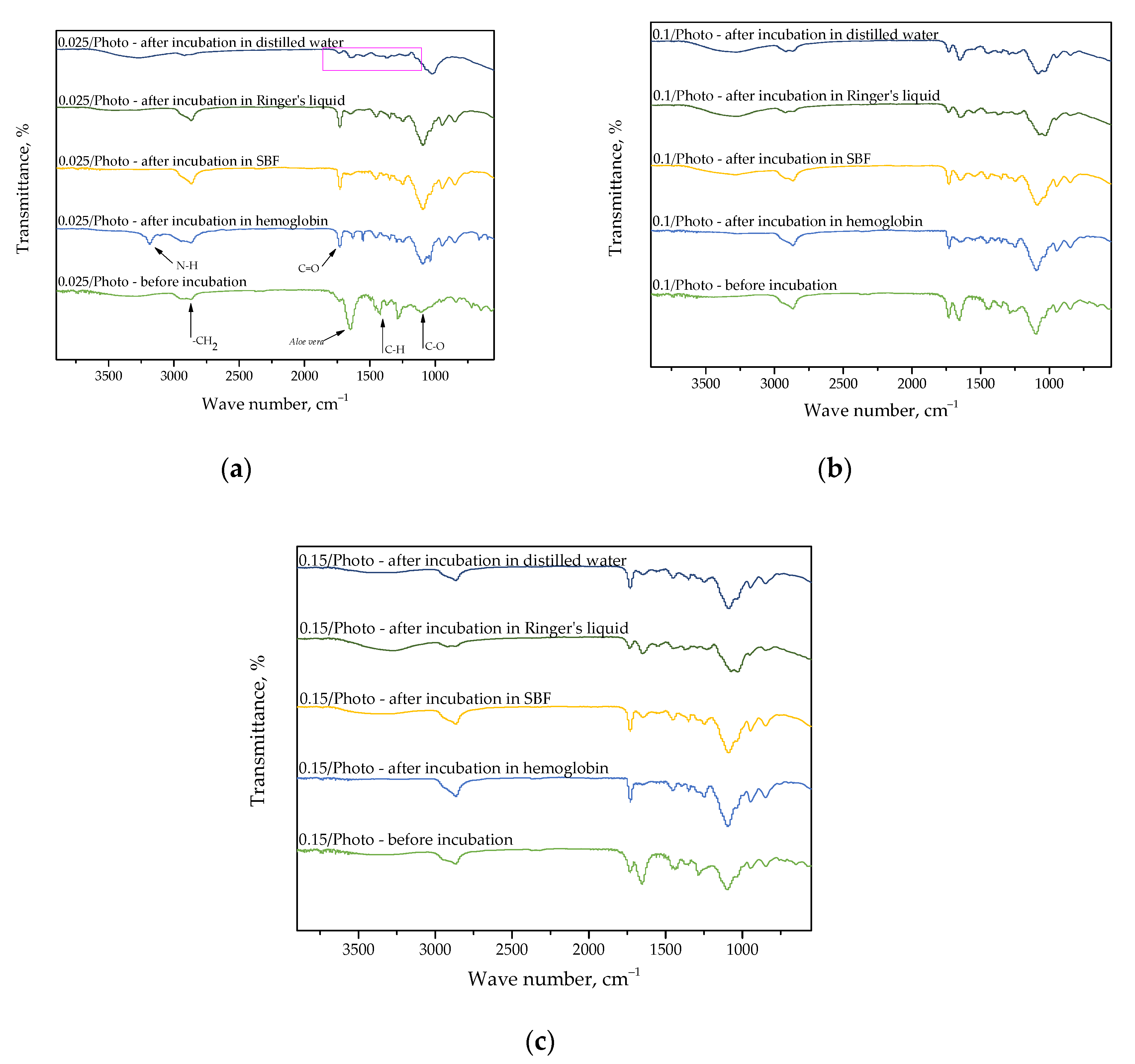



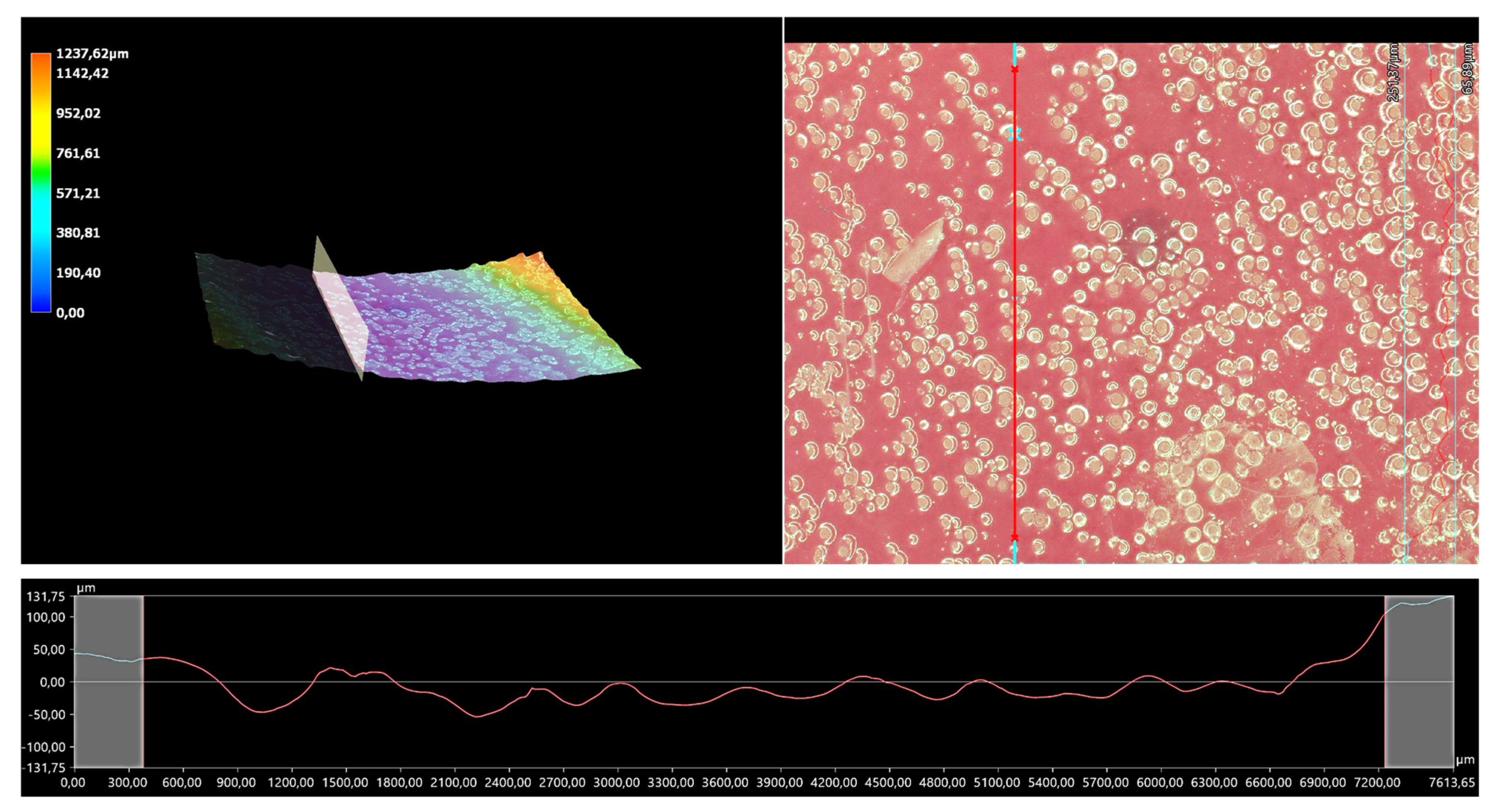
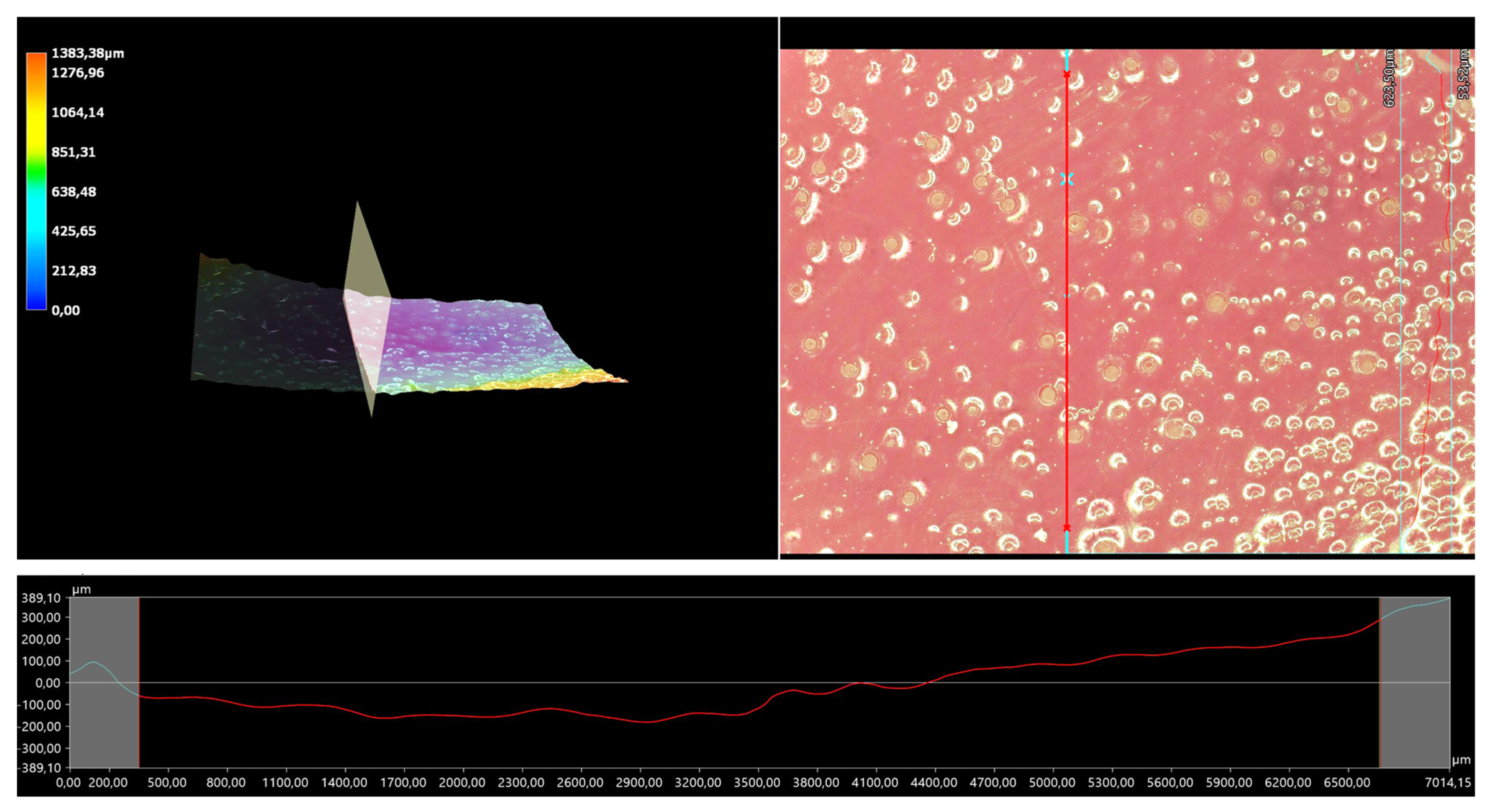


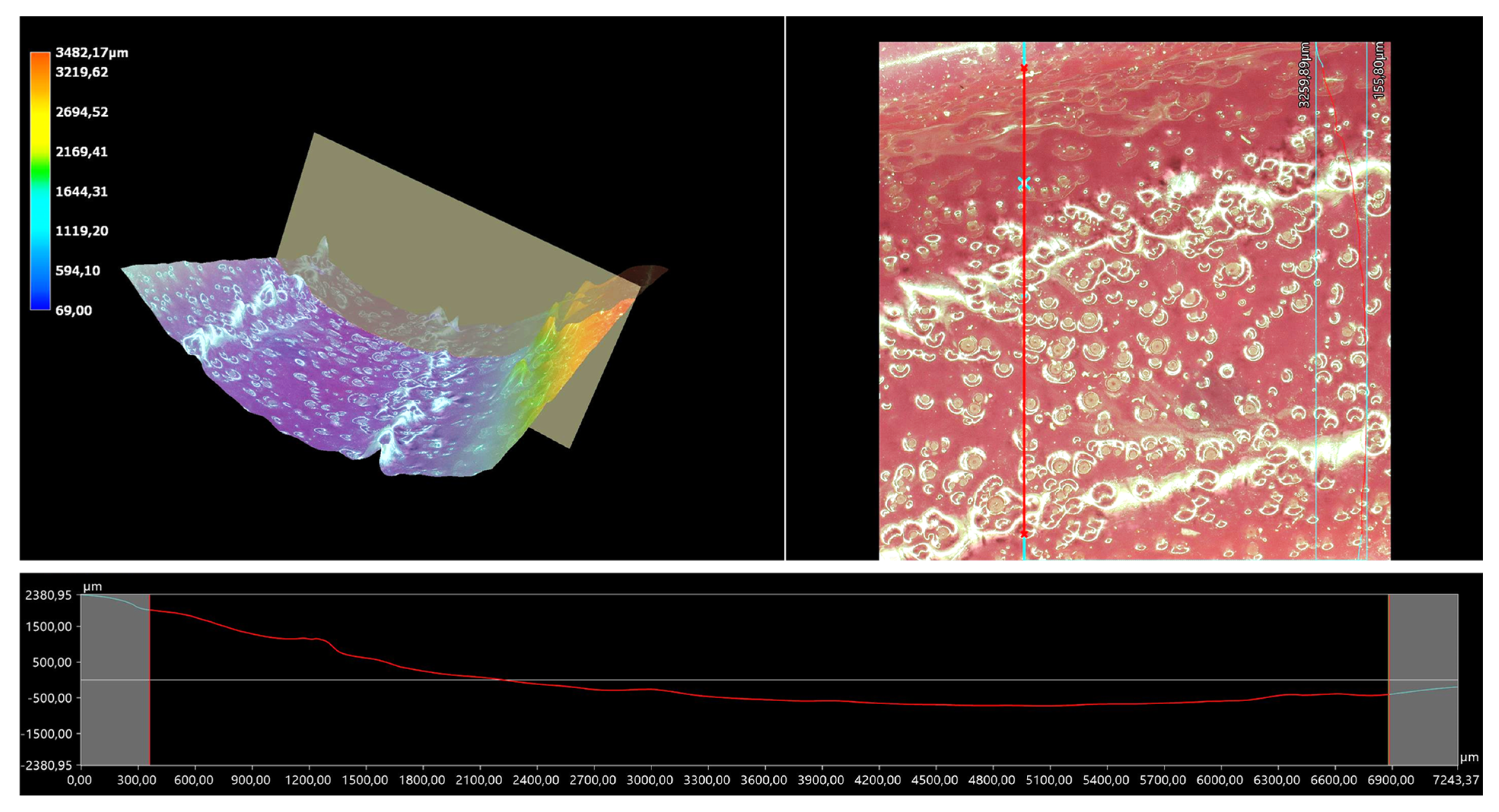
| Sample | Solution of PVP, 15%, mL | Aloe vera Juice, mL | Solution of Vitamin C, 5%, mL | Crosslinking Agent, mL | Photoinitiator, mL |
|---|---|---|---|---|---|
| 0.025/Photo | 7 | 3 | 2 | 3 | 0.025 |
| 0.075/Photo | 0.075 | ||||
| 0.100/Photo | 0.100 | ||||
| 0.125/Photo | 0.125 | ||||
| 0.150/Photo | 0.150 |
| Independent Variable | p * |
|---|---|
| Photoinitiator content | 0.00409 |
| Type of liquid | 0.01033 |
| Independent Variable | p * |
|---|---|
| Amount of photoinitiator contributing towards the tensile strength | |
| Amount of photoinitiator contributing towards the percentage elongation |
| Sample | Contact Angle | Surface Free Energy | |||
|---|---|---|---|---|---|
| Water | Diiodomethane | Polar, mJ/m2 | Dispersive, mJ/m2 | Total Free Energy, mJ/m2 | |
| 0.025/Photo | 1.78 | 1.46 | 0.38 | 1.09 | 1.14 |
| 0.075/Photo | 0.64 | 0.88 | 0.72 | 0.94 | 0.89 |
| 0.100/Photo | 0.99 | 1.18 | 0.49 | 0.78 | 1.02 |
| 0.125/Photo | 1.23 | 0.58 | 0.27 | 0.71 | 0.77 |
| 0.150/Photo | 1.01 | 0.79 | 0.98 | 0.38 | 0.39 |
| Sample | Ra (Arithmetic Mean Height of the Surface), μm | Sz (Maximum Height of the Surface), μm |
|---|---|---|
| 0.025/Photo | 20.74 | 157.00 |
| 0.075/Photo | 117.16 | 468.69 |
| 0.100/Photo | 49.36 | 182.85 |
| 0.125/Photo | 166.15 | 702.45 |
| 0.150/Photo | 627.49 | 2680.67 |
Disclaimer/Publisher’s Note: The statements, opinions and data contained in all publications are solely those of the individual author(s) and contributor(s) and not of MDPI and/or the editor(s). MDPI and/or the editor(s) disclaim responsibility for any injury to people or property resulting from any ideas, methods, instructions or products referred to in the content. |
© 2022 by the authors. Licensee MDPI, Basel, Switzerland. This article is an open access article distributed under the terms and conditions of the Creative Commons Attribution (CC BY) license (https://creativecommons.org/licenses/by/4.0/).
Share and Cite
Kędzierska, M.; Kudłacik-Kramarczyk, S.; Jamroży, M.; Bańkosz, M.; Walter, J.; Potemski, P.; Drabczyk, A. Verification of the Influence of the 2-Hydroxy-2-methylpropiophenone (Photoinitiator) Content in Hydrogel Materials on Their Physicochemical Properties and Surface Morphology. Coatings 2023, 13, 40. https://doi.org/10.3390/coatings13010040
Kędzierska M, Kudłacik-Kramarczyk S, Jamroży M, Bańkosz M, Walter J, Potemski P, Drabczyk A. Verification of the Influence of the 2-Hydroxy-2-methylpropiophenone (Photoinitiator) Content in Hydrogel Materials on Their Physicochemical Properties and Surface Morphology. Coatings. 2023; 13(1):40. https://doi.org/10.3390/coatings13010040
Chicago/Turabian StyleKędzierska, Magdalena, Sonia Kudłacik-Kramarczyk, Mateusz Jamroży, Magdalena Bańkosz, Janusz Walter, Piotr Potemski, and Anna Drabczyk. 2023. "Verification of the Influence of the 2-Hydroxy-2-methylpropiophenone (Photoinitiator) Content in Hydrogel Materials on Their Physicochemical Properties and Surface Morphology" Coatings 13, no. 1: 40. https://doi.org/10.3390/coatings13010040
APA StyleKędzierska, M., Kudłacik-Kramarczyk, S., Jamroży, M., Bańkosz, M., Walter, J., Potemski, P., & Drabczyk, A. (2023). Verification of the Influence of the 2-Hydroxy-2-methylpropiophenone (Photoinitiator) Content in Hydrogel Materials on Their Physicochemical Properties and Surface Morphology. Coatings, 13(1), 40. https://doi.org/10.3390/coatings13010040






